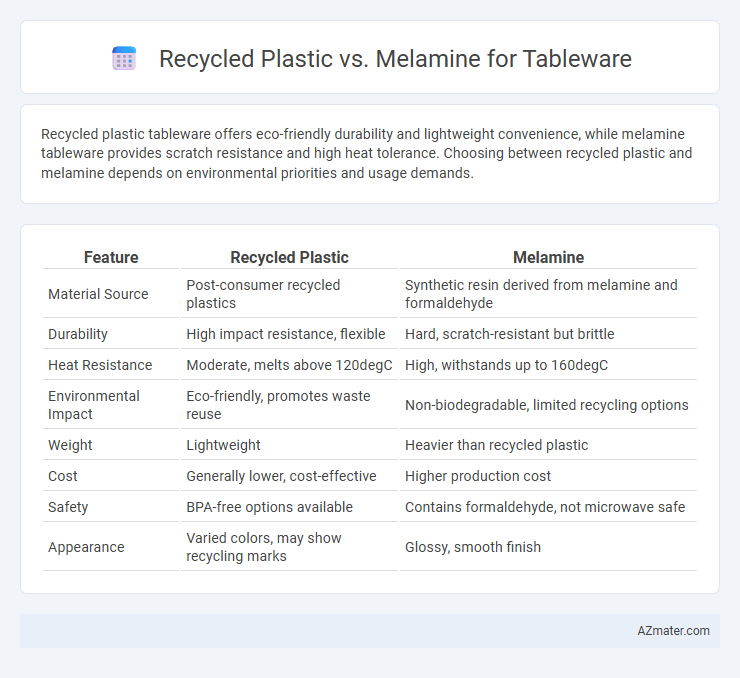Recycled plastic tableware offers eco-friendly durability and lightweight convenience, while melamine tableware provides scratch resistance and high heat tolerance. Choosing between recycled plastic and melamine depends on environmental priorities and usage demands.
Table of Comparison
| Feature | Recycled Plastic | Melamine |
|---|---|---|
| Material Source | Post-consumer recycled plastics | Synthetic resin derived from melamine and formaldehyde |
| Durability | High impact resistance, flexible | Hard, scratch-resistant but brittle |
| Heat Resistance | Moderate, melts above 120degC | High, withstands up to 160degC |
| Environmental Impact | Eco-friendly, promotes waste reuse | Non-biodegradable, limited recycling options |
| Weight | Lightweight | Heavier than recycled plastic |
| Cost | Generally lower, cost-effective | Higher production cost |
| Safety | BPA-free options available | Contains formaldehyde, not microwave safe |
| Appearance | Varied colors, may show recycling marks | Glossy, smooth finish |
Introduction: The Growing Demand for Sustainable Tableware
The demand for sustainable tableware has surged as consumers prioritize eco-friendly materials, prompting a shift from traditional options to recycled plastics and melamine. Recycled plastic tableware offers a significant environmental benefit by repurposing waste, reducing landfill impact and conserving resources. Melamine remains popular for its durability and aesthetic appeal, though concerns over its non-biodegradability and potential chemical exposure drive interest in more sustainable alternatives like recycled plastics.
What is Recycled Plastic Tableware?
Recycled plastic tableware is made from post-consumer or post-industrial plastic waste that is processed and molded into durable plates, bowls, and utensils, reducing environmental impact by diverting plastic from landfills and oceans. It offers lightweight, shatter-resistant alternatives to traditional materials, making it ideal for outdoor use, picnics, and casual dining. Unlike melamine, which is a thermoset plastic derived from resin and formaldehyde, recycled plastic emphasizes sustainability and circular economy principles through material reuse.
What is Melamine Tableware?
Melamine tableware is made from a durable thermosetting plastic resin known for its lightweight, shatter-resistant properties and vibrant design capabilities. It offers a heat-resistant and non-porous surface, making it suitable for everyday use while being less prone to cracking compared to recycled plastic alternatives. Though melamine tableware is not microwave-safe, its hardness and aesthetic versatility make it a popular choice for both residential and commercial dining settings.
Environmental Impact: Recycled Plastic vs Melamine
Recycled plastic tableware significantly reduces waste by repurposing post-consumer materials, lowering the demand for virgin plastic production and minimizing landfill accumulation. Melamine, derived from formaldehyde and urea, is durable but non-biodegradable and often difficult to recycle, contributing to long-term environmental pollution. Choosing recycled plastic over melamine supports a circular economy and decreases overall carbon footprint in the tableware lifecycle.
Durability and Longevity Comparison
Recycled plastic tableware demonstrates impressive durability by resisting shattering and withstands frequent use in both indoor and outdoor settings without significant wear. Melamine tableware offers high resistance to heat and impact, maintaining its structural integrity over prolonged usage, though it can chip or crack under extreme force. Both materials provide long-lasting options, with recycled plastic excelling in flexibility and melamine favored for scratch resistance and heat tolerance.
Safety and Health Concerns
Recycled plastic tableware may contain trace amounts of contaminants or chemical residues that pose potential health risks, particularly if not processed under stringent safety standards. Melamine tableware, while durable and heat-resistant, can release harmful melamine and formaldehyde compounds if exposed to high temperatures or acidic foods, raising safety concerns. Choosing certified BPA-free recycled plastics or food-grade melamine with proper usage guidelines minimizes exposure to toxic substances, ensuring safer dining experiences.
Aesthetic and Design Possibilities
Recycled plastic tableware offers versatile aesthetics with a wide range of colors, textures, and shapes enabled by advanced molding techniques, making it ideal for eco-conscious, contemporary designs. Melamine tableware provides a smooth, glossy finish with durable, vibrant patterns, often mimicking ceramic or porcelain for a classic look in both casual and formal settings. While recycled plastic emphasizes sustainability with customizable styles, melamine excels in delivering timeless elegance and intricate designs.
Cost Analysis: Initial and Long-term
Recycled plastic tableware generally offers a lower initial cost compared to melamine, making it an economical choice for budget-conscious consumers. Over the long term, recycled plastic may incur higher replacement expenses due to its lower durability and susceptibility to wear, while melamine's sturdiness provides extended use and cost-efficiency despite a higher upfront price. Maintenance costs for recycled plastic are minimal, but melamine benefits from its resistance to stains and scratches, reducing the need for frequent replacement and ultimately lowering total cost of ownership.
Consumer Trends and Preferences
Recycled plastic tableware appeals to eco-conscious consumers seeking sustainable and lightweight options with reduced environmental impact, while melamine remains favored for its durability, heat resistance, and vibrant design possibilities. Growing demand for environmentally friendly products boosts recycled plastic's market share, particularly among younger demographics prioritizing circular economy values. Preferences shift towards recycled plastic for casual, everyday use, whereas melamine is preferred in settings needing long-lasting, stylish tableware.
Which is Better for Eco-Friendly Tableware?
Recycled plastic tableware reduces landfill waste and lowers carbon emissions by repurposing existing materials, making it a sustainable choice for eco-friendly dining. Melamine, while durable and lightweight, is made from non-renewable petrochemicals and is less biodegradable, posing greater environmental challenges at end-of-life. Choosing recycled plastic supports circular economy principles and offers a greener alternative for environmentally conscious consumers seeking sustainable tableware options.

Infographic: Recycled plastic vs Melamine for Tableware
 azmater.com
azmater.com